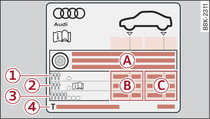|

- Fig. 1 End face of driver's door: Sticker listing the tyre pressures
The correct inflation pressures for tyres fitted at the factory and for the compact temporary spare wheel* are specified on a sticker. The sticker Fig. 1 is on the end face of the driver's door.
-A- Tyre size
-B- Tyre pressure for the front wheels
-C- Tyre pressure for the rear wheels
-1- Tyre pressure if vehicle is partially loaded
-2- Tyre pressure (comfort setting)* if vehicle is partially loaded (not available on all vehicles)
-3- Tyre pressure if vehicle is fully loaded
-4- Tyre pressure for the compact temporary spare wheel*
If you intend to drive the vehicle with a partial load, adjust the tyre pressures to the specified setting -1-. However, if you prefer an extra-smooth ride you can select the comfort setting* -2-. Should you wish to drive with a full load, you must increase the tyre pressure to the specified maximum -3- WARNING!.
Checking / adjusting the tyre pressures
Check the tyre pressures at least once a month and, in addition, before starting a long journey.
The tyre pressures should only be checked when the tyres are cold. The slightly raised pressures of warm tyres must not be reduced.
Refer to the sticker Fig. 1 for the correct tyre pressures according to the load the vehicle is carrying.
If necessary, adjust the tyre pressure.
[a998]Applies to: vehicles with tyre pressure loss indicator
Then store the new tyre pressures in the infotainment system ►Link.
[a996]Applies to: vehicles with tyre pressure loss indicator
Check the pressure of the spare wheel*/compact temporary spare wheel*. Keep the spare tyre inflated to the highest pressure approved for the tyre.
Always adjust the tyre pressures to match your driving style and the load the vehicle is carrying.
- Excessive loads can cause you to lose control of the vehicle – risk of accident!
- Under-inflated tyres flex more and can overheat at high speeds or when the vehicle is carrying a heavy load. This could cause a tyre blow-out and you could lose control of the vehicle – risk of accident!
- Incorrect tyre pressures increase tyre wear and adversely affect vehicle braking and handling – risk of accident!
Caution!
Replace any lost valve caps to prevent damage to the tyre valves.
For the sake of the environment
- Under-inflated tyres will increase the fuel consumption.
- Driving with the tyre pressures adjusted to the comfort setting* may also result in increased fuel consumption.
Note
We recommend always using the tyre pressure setting -1- for partial loads and the setting -3- for full loads.
